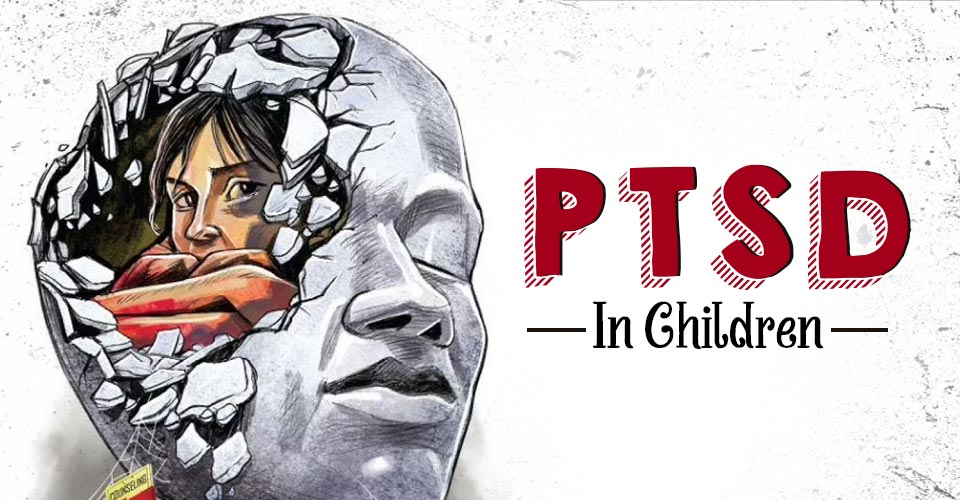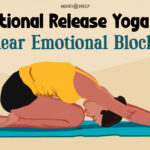Post-Traumatic Stress Disorder (PTSD) is a psychological disorder 1 Fariba, K., & Gupta, V. (2021). Post traumatic Stress Disorder In Children. PubMed; StatPearls Publishing. Available from: https://www.ncbi.nlm.nih.gov/books/NBK559140/ that can affect children who have undergone or witnessed a traumatic event. These events encompass a range of experiences, such as physical or sexual abuse, accidents, natural disasters, violence, or sudden bereavement.
Table of Contents
The symptoms of PTSD in children are characterized by intrusive and distressing thoughts, nightmares, flashbacks, emotional detachment, heightened arousal, avoidance behaviors, and changes in mood and behavior.
The manifestation of PTSD in children is diverse, contingent upon the individual and the specific traumatic event. For instance, a child involved in a car accident might exhibit fear or anxiety in relation to cars or driving, while a child who has witnessed domestic violence may display heightened aggression or hyper-alertness.
The onset of PTSD symptoms in children can vary, although it often emerges within the first six months 2 Fariba, K., & Gupta, V. (2021). Posttraumatic Stress Disorder In Children. PubMed; StatPearls Publishing. Available from: https://www.ncbi.nlm.nih.gov/books/NBK559140/ following the traumatic incident. The prevalence of PTSD is estimated to be between 3% and 15% 3 Hitchcock, C., Goodall, B., Sharples, O., Meiser-Stedman, R., Watson, P., Ford, T., & Dalgleish, T. (2021). Population Prevalence of the Posttraumatic Stress Disorder Subtype for Young Children in Nationwide Surveys of the British General Population and of Children in Care. Journal of the American Academy of Child and Adolescent Psychiatry, 60(10), 1278–1287.e3. https://doi.org/10.1016/j.jaac.2020.12.036 in girls and 1% to 6% in boys.
Case Example:
Jason Adams, a 12-year-old boy, grew up in a small-town challenging environment marked by parental substance abuse and neglect. His father physically and verbally abused both his mother and himself. One year ago, Jason witnessed a close friend being violently assaulted by older teenagers. He felt helpless and terrified during the attack, as he failed to rescue his friend and escape to safety.
Following this event, Jason began experiencing horrible flashbacks, nightmares, and negative thoughts related to the assault. These visions traumatized him and made him fearful. He started avoiding his friends and stopped going about town.
He was easily aroused and disturbed by mere noises and similar insignificant things. Gradually, he started experiencing sleep difficulties, irritability, and impaired concentration. These symptoms affected his academic performance, mental well-being, and daily functioning.
Case Analysis:
From the present case, it can be observed that Jason experiences signs of intrusive negative thoughts, repetitive nightmares, traumatic flashbacks, difficulty accepting and working adequately with the real-life situation, alongside signs of anxiety, trauma, and problematic areas in cognitive functioning. All of his behavior reflects that Jason has significant symptoms of childhood PTSD.
Signs of PTSD in Children
Here are some common signs 4 Pinquart M. (2018). Posttraumatic Stress Symptoms and Disorders in Children and Adolescents with Chronic Physical Illnesses: a Meta-Analysis. Journal of child & adolescent trauma, 13(1), 1–10. https://doi.org/10.1007/s40653-018-0222-z and symptoms of PTSD in children:
- Experience insomnia or difficulty sleeping.
- Struggle to display affection or have difficulty feeling emotionally connected.
- Withdraw from social interactions and isolate themselves from others, feeling disconnected and detached
- Experience flashbacks, which can manifest as vivid images, sounds, smells, or feelings, leading the child to believe the event is recurring.
- Encounter difficulties in school, such as academic performance or social interactions.
- Display regressive behaviors for their age, such as thumb-sucking or bedwetting.
- Report physical symptoms, including headaches or stomachaches, and shivering.
Causes of PTSD in Children
Children can develop 5 Yang, F., Wen, J., Huang, N., Riem, M. M. E., Lodder, P., & Guo, J. (2022). Prevalence and related factors of child posttraumatic stress disorder during COVID-19 pandemic: A systematic review and meta-analysis. European psychiatry : the journal of the Association of European Psychiatrists, 65(1), e37. https://doi.org/10.1192/j.eurpsy.2022.31 PTSD as a result of various traumatic events, including:
- Severe accidents, such as car or train wrecks.
- Invasive medical procedures, particularly for children under the age of 6.
- Animal bites or attacks.
- Natural disasters, such as floods or earthquakes.
- Violent personal assaults, including muggings, rape, torture, or kidnappings.
- Physical abuse perpetrated by caregivers or others.
- Sexual abuse involves inappropriate sexual behavior or exploitation.
- Emotional abuse or bullying, is characterized by consistent humiliation, threats, or intimidation.
- Neglect refers to a failure to provide basic physical or emotional needs by caregivers.
How Childhood PTSD Affects Mental Health
PTSD can have significant impacts 6 Danese, A., McLaughlin, K. A., Samara, M., & Stover, C. S. (2020). Psychopathology in children exposed to trauma: detection and intervention needed to reduce downstream burden. BMJ (Clinical research ed.), 371, m3073. https://doi.org/10.1136/bmj.m3073 on children’s mental health functioning, which include:
- Heightened anger and aggression, which can manifest in outbursts, irritability, and conflicts with others.
- General mistrust toward others makes it challenging for them to form and maintain relationships.
- Symptoms of depression, include persistent sadness, changes in appetite and sleep patterns, self-harming behavior, and feelings of guilt.
- Anxiety disorders such as excessive worry, fear, restlessness, or avoidance of specific situations.
- Difficulties with attention, concentration, hyperactivity, and impulse control, lead to symptoms similar to Attention deficit hyperactivity disorder.
How to Diagnose Childhood PTSD?
Diagnosing childhood PTSD typically involves 7 Cohen, J. A., & Scheeringa, M. S. (2009). Post-traumatic stress disorder diagnosis in children: challenges and promises. Dialogues in clinical neuroscience, 11(1), 91–99. https://doi.org/10.31887/DCNS.2009.11.1/jacohen a comprehensive assessment conducted by a qualified mental health professional, such as:
1. Initial Evaluation
Interviewing the child along with parents, or teachers to gather information about the child’s symptoms, medical history, and any traumatic events that may have occurred.
2. Diagnostic Criteria
Adequately assessing whether the child meets the diagnostic criteria 8 Center for Substance Abuse Treatment (US). (2014). DSM-5 Diagnostic Criteria for PTSD. Nih.gov; Substance Abuse and Mental Health Services Administration (US). Available from: https://www.ncbi.nlm.nih.gov/books/NBK207191/box/part1_ch3.box16/ for PTSD as outlined in the Diagnostic and Statistical Manual of Mental Disorders (DSM-5). This includes exposure to a traumatic event, the presence of specific symptoms, and the duration and impact of these symptoms on the child’s daily functioning.
3. Assessment Tools
Application of standardized assessment tools 9 Mathew, G., Varghese, A. D., Sabu, A. M., & Joseph, A. (2021). Screening for post-traumatic stress disorder among adolescents following floods- a comparative study from private and public schools in Kerala, India. BMC pediatrics, 21(1), 462. https://doi.org/10.1186/s12887-021-02933-4 , such as the Clinician-administered PTSD scale (CAPS), Structured clinical interview for DSM (SCID) to gather additional information about the child’s symptoms and their severity.
Treatment for PTSD in Children
Different treatment approaches 10 Danzi, B. A., & La Greca, A. M. (2021). Treating Children and Adolescents with Posttraumatic Stress Disorder: Moderators of Treatment Response. Journal of clinical child and adolescent psychology : the official journal for the Society of Clinical Child and Adolescent Psychology, American Psychological Association, Division 53, 50(4), 510–516. https://doi.org/10.1080/15374416.2020.1823849 for PTSD among children include:
1. Trauma-focused Cognitive-behavioral Therapy (TF-CBT)
This therapy aims to help children 11 de Arellano, M. A., Lyman, D. R., Jobe-Shields, L., George, P., Dougherty, R. H., Daniels, A. S., Ghose, S. S., Huang, L., & Delphin-Rittmon, M. E. (2014). Trauma-focused cognitive-behavioral therapy for children and adolescents: assessing the evidence. Psychiatric services (Washington, D.C.), 65(5), 591–602. https://doi.org/10.1176/appi.ps.201300255 process traumatic memories and develop coping skills, and also helps in cognitive restructuring, and gradual exposure to trauma reminders.
Read More About CBT Here
2. Eye Movement Desensitization and Reprocessing (EMDR)
This therapy utilizes 12 Karadag, M., Gokcen, C., & Sarp, A. S. (2020). EMDR therapy in children and adolescents who have post-traumatic stress disorder: a six-week follow-up study. International journal of psychiatry in clinical practice, 24(1), 77–82. https://doi.org/10.1080/13651501.2019.1682171 bilateral stimulation (such as eye movements) to facilitate the processing of traumatic memories and the development of more adaptive beliefs and emotions.
3. Play Therapy
Play therapy for PTSD in children allows them to express 13 Humble, J. J., Summers, N. L., Villarreal, V., Styck, K. M., Sullivan, J. R., Hechler, J. M., & Warren, B. S. (2018). Child-Centered Play Therapy for Youths Who Have Experienced Trauma: a Systematic Literature Review. Journal of child & adolescent trauma, 12(3), 365–375. https://doi.org/10.1007/s40653-018-0235-7 their feelings and experiences through various play techniques and toys to help children process trauma, enhance emotional regulation, and develop coping skills.
4. Parent-child Interaction Therapy (PCIT)
It helps improve the parent-child 14 Lieneman, C. C., Brabson, L. A., Highlander, A., Wallace, N. M., & McNeil, C. B. (2017). Parent-Child Interaction Therapy: current perspectives. Psychology research and behavior management, 10, 239–256. https://doi.org/10.2147/PRBM.S91200 relationship and enhances parenting skills for the parents with an aim to provide a safe and supportive environment for their children, promoting their sense of security and attachment.
5. Art Therapy
Children can use various art forms 15 Bosgraaf, L., Spreen, M., Pattiselanno, K., & van Hooren, S. (2020). Art Therapy for Psychosocial Problems in Children and Adolescents: A Systematic Narrative Review on Art Therapeutic Means and Forms of Expression, Therapist Behavior, and Supposed Mechanisms of Change. Frontiers in psychology, 11, 584685. https://doi.org/10.3389/fpsyg.2020.584685 , such as drawing or painting, to express and process their emotions related to the traumatic event.
Read More About Art Therapy Here
6. Mindfulness-based Interventions
Mindfulness techniques, such as 16 Boyd, J. E., Lanius, R. A., & McKinnon, M. C. (2018). Mindfulness-based treatments for posttraumatic stress disorder: a review of the treatment literature and neurobiological evidence. Journal of psychiatry & neuroscience : JPN, 43(1), 7–25. https://doi.org/10.1503/jpn.170021 breathing exercises and guided meditation, can help children develop awareness of their thoughts and emotions, manage distressing symptoms, and improve overall well-being.
Read More About Mindfulness Here
7. Medication
In some cases, medication may be prescribed to manage specific symptoms associated with PTSD, such as anxiety or sleep disturbances. Medication is typically used in combination with therapy and under the guidance of a qualified healthcare professional.
How to Help Your Child with PTSD?
Here are some tips for parents to support 17 Pediatrics, T. N. A. of M. E. P. on S. U. D. in, Bundock, E. A., Corey, T. S., Andrew, T. A., Crandall, L. G., Eason, E. A., Gunther, W. M., Moon, R. Y., Palusci, V. J., Schmidt, C. M., & Sens, M. A. (2019). Tips for Talking With and Helping Children and Youth Cope After a Disaster or Traumatic Event. In www.ncbi.nlm.nih.gov. Academic Forensic Pathology International. Available from: https://www.ncbi.nlm.nih.gov/books/NBK577026/ their children in their recovery from PTSD:
- Be understanding, supportive, and affectionate, allowing your child the necessary time to adjust to their traumatic experiences.
- Maintain consistency and stability in their daily routines, avoiding unnecessary changes that could disrupt their sense of security.
- Create a safe space for your child to express their feelings and acknowledge their strength in facing the traumatic event.
- Consider your child in a support group for trauma survivors, as sharing experiences with peers can provide further understanding and validation.
- Reassure your child that they are not responsible for the traumatic event and encourage open discussions regarding any feelings of guilt they may have.
- If your child shows symptoms such as sadness, anxiety, social withdrawal, declining academic performance, and thoughts of self-harm or suicide, seek immediate treatment from a mental health professional.
- Maintain regular communication with your child’s teachers, therapist, or other caregivers, providing them with relevant information and updates.
Takeaway
Post-traumatic stress disorder in children is a serious mental health condition that requires understanding, support, and professional intervention. By being attentive, patient, and responsive to their needs, parents can play a crucial role in their child’s recovery.
Creating a safe and stable environment, encouraging open communication, and seeking appropriate therapy for PTSD in children can help them to heal, regain a sense of security, and move forward toward a healthier and happier life.
At A Glance
- Post-Traumatic Stress Disorder (PTSD) is a psychological disorder that can affect children who have undergone or witnessed a traumatic event.
- Signs of PTSD in children include difficulty sleeping, loss of interest, physical symptoms, etc.
- PTSD in children can be caused by traumatic events such as natural disasters, sexual abuse, or negligence by caregivers.
- PTSD can cause depression, anxiety, and attention deficit hyperactivity disorder among children.
- Mental health professionals assess PTSD by initial interview, using screening tools and diagnostic criteria mentioned in DSM-5.
- Trauma-focused cognitive behavior therapy, art therapy, mindfulness, and medication can be referred to as a treatment for PTSD in children.
- Creating a safe and stable environment and encouraging open communication by parents can help children with PTSD to regain a sense of security and belongingness.
Frequently Asked Questions (FAQs)
1. Can childhood PTSD go away?
Yes, childhood trauma can be healed with the right therapeutic approach and parental support.
2. How do PTSD children behave?
Children who have endured complex trauma often face challenges in recognizing, articulating, and regulating their emotions. They may struggle with limited vocabulary when it comes to expressing their internal emotional experiences.
3. What happens if PTSD is left untreated in a child?
Children experiencing PTSD may face developmental challenges that can impact various areas of their functioning such as cognitive development, lower academic performance, difficulties with memory and attention, impaired social and emotional responses, and a tendency towards defensive or guarded behavior.















